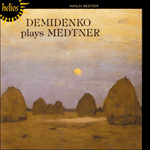It is unclear what Medtner understood by the word ‘Dithyramb’, often said to be a hymn to the Greek gods of wine and fertility, although even classical scholars cannot agree on its precise meaning or evolution. Schiller’s poem with the same title (set by Schubert) is a general paean to the gods, so it is possible that Medtner (well versed in German literature from childhood) took his inspiration from there. From his Three Dithyrambs Op 10, and from the last movement of his Violin Sonata No 1, Op 21 (similarly entitled and marked Festivamente), we can deduce that he thought of it as some kind of solemn ceremony or celebration, almost a ritual, never more so than in the four portentous gong strokes which begin the first piece of Op 10 (Maestoso severamente) and are never far away, either in the foreground or buried in the texture. The second and greatest Dithyramb carries a footnote: ‘In the manner of a sermon, that is of a theme freely interpreted and varied.’ The theme itself is grandiloquent and surprisingly diatonic but the undulating quintuplets and chromatic adventures of the development bring a note of anxiety which is swept away by the return of the main theme decked in resplendent virtuoso garb (grandisonante) and capped by a blistering Prestissimo coda. The third Dithyramb (Andantino innocente), in effect a kind of postlude, is comparatively mild, even pastoral in tone, but still proceeds with a stately tread.
from notes by Hamish Milne © 2012
On ignore ce que Medtner entendait exactement par le mot «Dithyrambe», souvent qualifié d’hymne aux dieux grecs du vin et de la fertilité, mais même les spécialistes des lettres classiques ne s’accordent pas sur son sens précis ou son évolution. Le poème de Schiller qui porte ce même titre (mis en musique par Schubert) est un hymne général aux dieux et il est donc possible que Medtner (très versé dès l’enfance dans la littérature allemande) en ait tiré son inspiration. De ses Trois Dithyrambes, op. 10, et du dernier mouvement de sa Sonate pour violon et piano no 1, op. 21 (aussi intitulé et marqué Festivamente), on peut déduire qu’il le voyait comme une sorte de cérémonie ou célébration solennelle, presque un rituel, surtout dans les quatre coups de gong graves qui commencent le premier morceau de l’op. 10 (Maestoso severamente) et ne sont jamais très loin, soit au premier plan, soit enfouis dans la texture. Le deuxième Dithyrambe, le plus important, comporte un post-scriptum: «À la manière d’un sermon, c’est-à-dire d’un thème librement interprété et varié.» Le thème lui-même est grandiloquent et étonnamment diatonique, mais les quintolets sinueux et les aventures chromatiques du développement apportent une note d’anxiété qui est balayée par le retour du thème principal paré d’une resplendissante virtuosité (grandisonante) et couronné d’une coda Prestissimo torride. Le troisième Dithyrambe (Andantino innocente), qui est en fait une sorte de postlude, est relativement doux, voire pastoral, mais il avance néanmoins encore d’un pas imposant.
extrait des notes rédigées par Hamish Milne © 2012
Français: Marie-Stella Pâris
Es ist nicht klar, was Medtner unter dem Wort „Dithyrambe“ verstand, das oft als Hymne an die griechischen Götter des Weins und der Fruchtbarkeit erklärt wird, obwohl sich selbst die Forschung über die genaue Bedeutung und Wortherkunft nicht einig ist. Schillers gleichnamiges Gedicht (das Schubert vertonte) ist ein allgemeiner Lobgesang an die Götter, so dass es gut möglich ist, dass Medtner (der von Kindheit an in der deutschen Literatur bewandert war) sich davon hatte inspirieren lassen. Aus seinen Drei Dithyramben op. 10 sowie dem letzten Satz seiner Violinsonate Nr. 1, op. 21 (in ähnlicher Weise bezeichnet und mit Festivamente markiert) kann man schließen, dass er sich darunter eine Art feierlicher Zeremonie oder Zelebration vorstellte, fast in der Art eines Rituals, insbesondere bei den vier ominösen Gongschlägen, die das erste Stück von op. 10 eröffnen (Maestoso severamente) und stets anwesend bleiben, entweder im Vordergrund oder in der Textur versteckt. Die zweite und bedeutendste Dithyrambe enthält eine Fußnote: „In der Art einer Predigt, die ein Thema frei interpretiert und variiert.“ Das Thema selbst ist hochtönend und überraschend diatonisch, doch die welligen Quintolen und chromatischen Abenteuer der Durchführung sorgen für einen besorgten Ton, der dann aber durch die Wiederkehr des Hauptthemas in prächtiger Tracht (grandisonante) hinweggefegt und von einer glühenden Coda im Prestissimo sogar noch übertroffen wird. Die dritte Dithyrambe (Andantino innocente), sozusagen eine Art Nachspiel, ist vergleichsweise milde angelegt und schlägt sogar einen pastoralen Ton an, schreitet jedoch trotzdem in würdevollem Gang voran.
aus dem Begleittext von Hamish Milne © 2012
Deutsch: Viola Scheffel


 Medtner: Demidenko plays Medtner
Medtner: Demidenko plays Medtner
